I added some new links to the site (permanently added in the links section, obviously). These are websites that I use for my trips. They’re very useful for anyone looking to find animals out there, and often make the difference between a successful and skunk herping trip.
Weather: Wunderground.com
Moon Phase: U.S. Navy Astronomical Applications
AZ County Map: map_arizona_county
Online Spreadsheets: Google Docs
AZPARC Field Guide: reptilesofaz.com
Satellite Map: Google Earth
First and foremost, and not included on this list, is simply Google.com. The above links are useless without knowledge of the natural history, habits, and lifestyles of the animals you’re looking for.
Tags: fieldherper.com, google maps, gps, links, maps, notes, Research, temperatures, websites
Posted in Field Herping, Research | No Comments »
Continued from part 1, part 2, part 3, part 4, part 5 and part 6.
The rest of that day and evening were uneventful, unfortunately. We left the Superstitions and headed way out West of Phoenix to try and see some other species of Crotalus. To make things worse, temperatures were way down, even from the previously cool days. We started our hike in the Harcuvar mountains with overcast skies and temperatures just under 60 degrees. We saw a lot of great habitat, but no snakes sitting where they might if the sun were warming the adjacent rocks that day. Just to stick a fork in it, the wind was gusting bad enough to keep my hat in my free hand when anywhere near the ground. Two of us retreated to the flats to check low-lying washes since nothing was working up in the rocky hills.
Soon after, I heard a faint voice yelling something but couldn’t tell which direction it was coming from because of the wind. Eventually I heard it more clearly: “Gila Monster!”. Whoa.

Heloderma suspectrum
This was my third Gila Monster (Heloderma suspectrum) I’ve ever seen in the wild, and my second of this trip!

Gila Monster
After that we kept to the washes where temperatures were warmer and there was little wind. We saw a large zebra-tailed lizard (Callisaurus draconoides) hiding in the sand.

Zebra-Tailed Lizard

Zebra-Tailed Lizard
At that point we were doing more aimless wandering and talking than herping, so we decided to call it good. In a few days time, despite cool temperatures, high winds and a full moon, we managed quite a bit. Of only two rattlesnakes found, one was the trip target, the Black-Tailed rattlesnake. We also saw 2 of the more elusive and arguably cool venomous reptiles we have here in Arizona, in the coral snake and not one, but two gila monsters. This was definitely a trip to remember, and I was glad to have been able to share it with some new friends from the East.
The last snake we found was this desert patch-nosed snake (Salvadora hexalepis) I found laying across the road on the way out.

Salvadora hexalepis
Tags: Gila Monster, harcuvar, heloderma suspectrum, patch-nosed snake, patchnose, salvadora hexalepis, Zebra-Tailed Lizard
Posted in Field Herping, Field Trips, Photography | No Comments »
Continued from part 1, part 2, part 3, part 4, and part 5
The ground temperatures eventually got higher and we decided to head back to try another wash that had more cover, where I’d previously seen many of our target species, the Black-Tailed Rattlesnake (Crotaluss molossus). On the way, I jumped up and across a large boulder, setting off a short, barely audible “chk chk chk” in the darkness below which one of my herping partners was able to hear. I jumped off the rock and saw a loop of a large, desert phase Black-Tailed Rattlesnake disappearing into the depths. Finally our target species!
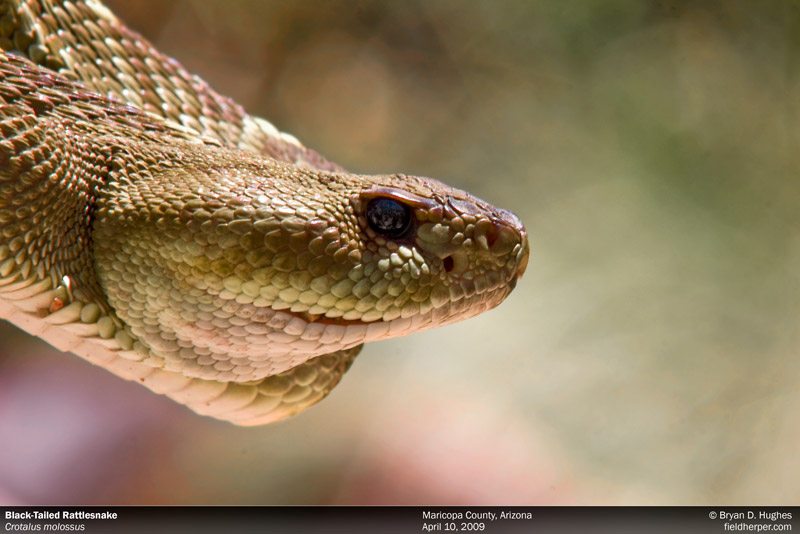
Crotalus molossus
This is my favorite species of the rattlesnakes that I have encountered in Arizona. They’re fairly common, but I never get tired of seeing them and the amazing variety of colors they seem to come in. This one was typical of the greenish, moderately contrasted animals I encounter in the Superstition mountains.
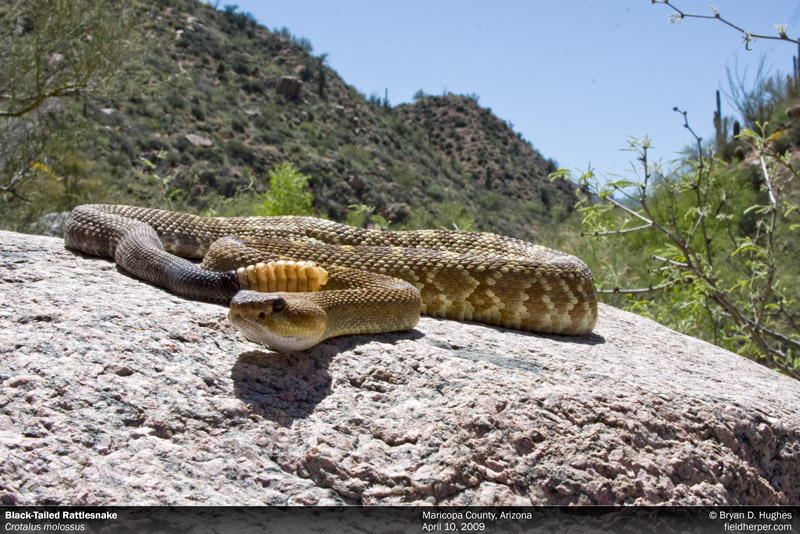
Black-Tailed Rattlesnake
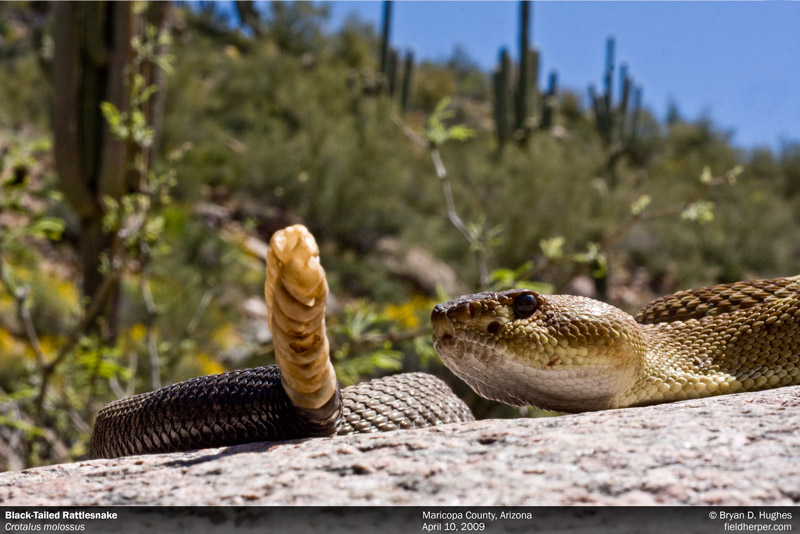
Crotalus molossus
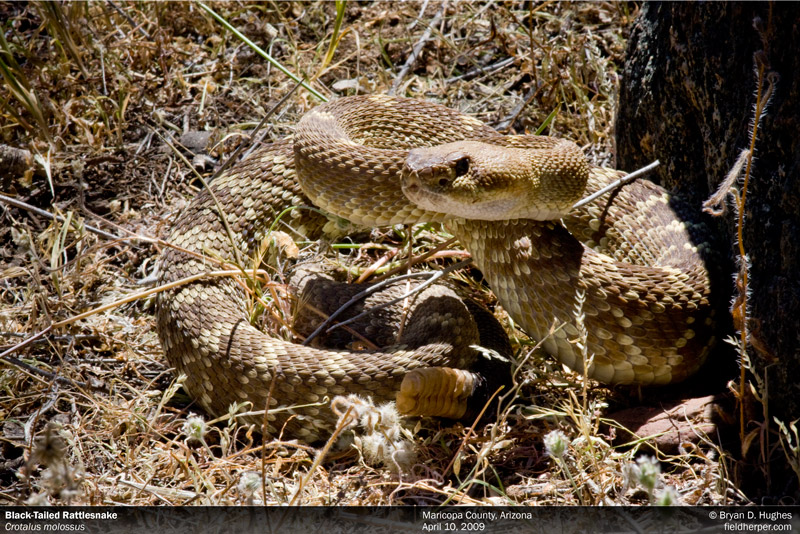
Crotalus molossus
It was released back to the boulder where we found it, and we went back to hike the originally planned upon wash, to no result other than another group of perfectly camoflaged canyon treefrogs (Hyla arenicolor).
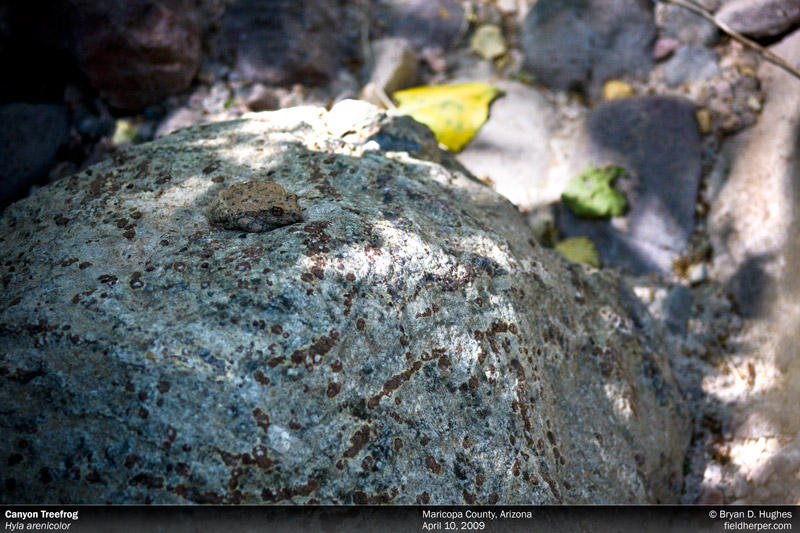
Hyla arenicolor
Tags: black-tailed rattlesnake, Blacktail, canyon treefrog, Crotalus molossus, Field Herping, Superstition Mountains
Posted in Field Herping, Field Trips, Photography | No Comments »
Continued from part 1, part 2, part 3 and part 4 …
After finding nothing else enjoying the morning sun, we started hiking an open, rocky wash I had spotted the day before as a possible place to find our target for the trip and my favorite of the rattlesnakes I’ve encountered so far, Crotalus molossus, the Black-Tailed Rattlesnake.
Within 50 yards from our point of entry, one of my herping partners saw a Western Diamondback Rattlesnake (Crotalus atrox) hiding in a rodent activity area under a large rock. Finally the first rattlesnake of the trip!

Crotalus atrox, in situ

Western Diamondback Rattlesnake
Continuing up the wash, well’camoflauged canyon treefrogs (Hyla arenicolor) were everywhere in various forms.
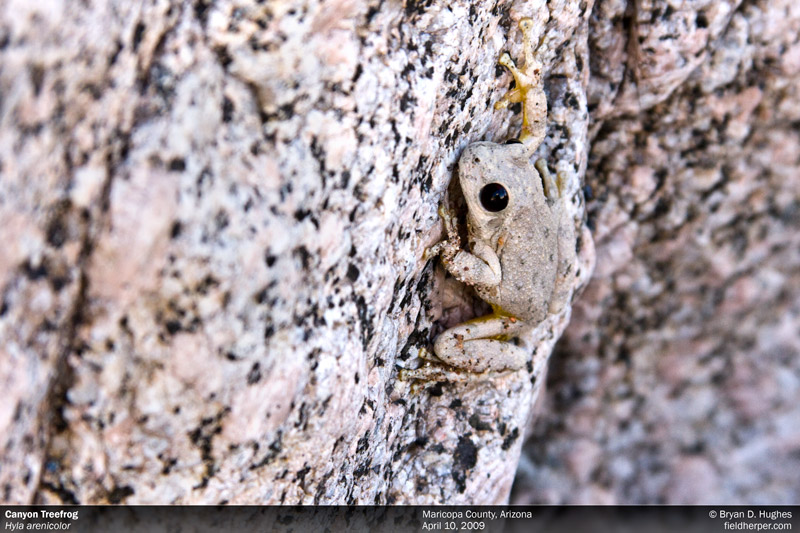
Hyla arenicolor
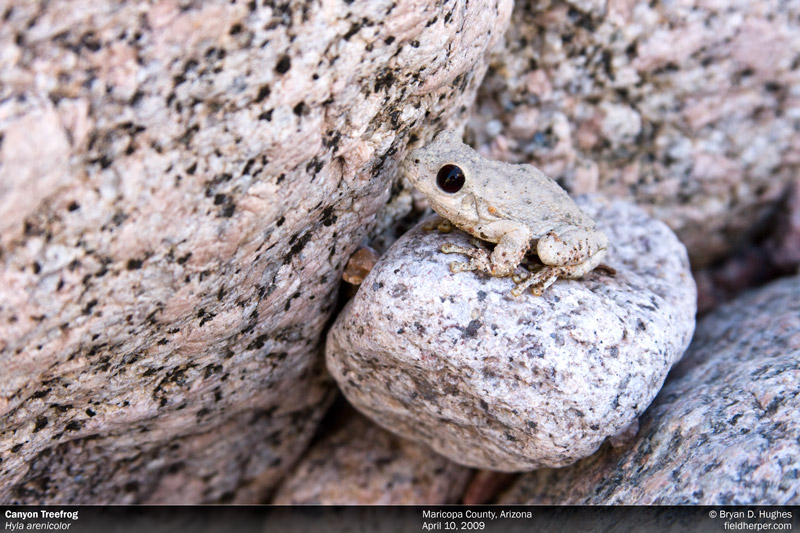
Canyon Treefrog
Canyon treefrogs display some amazing camouflage. There are 2 hiding in this crack doing their best rock impression.
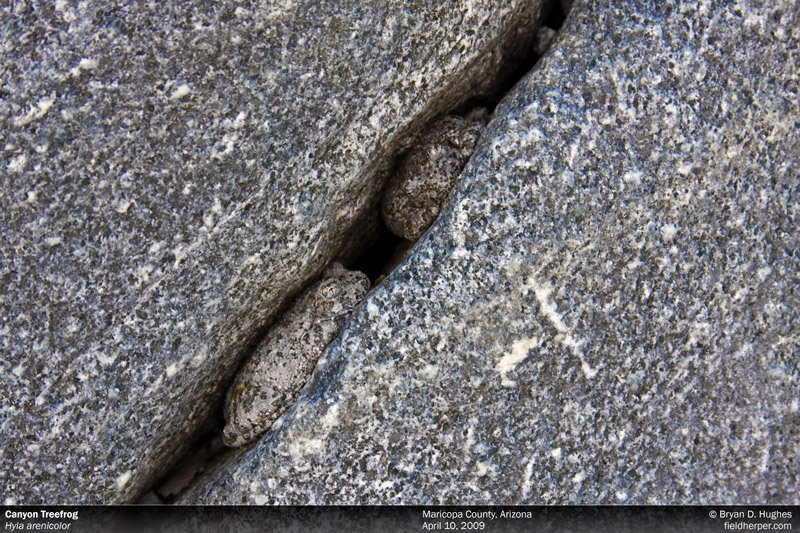
Canyon Treefrogs
The stream still had some moving water, in which each puddle was home to a good number of these lowland leopard frogs (Rana yavapaiensis).
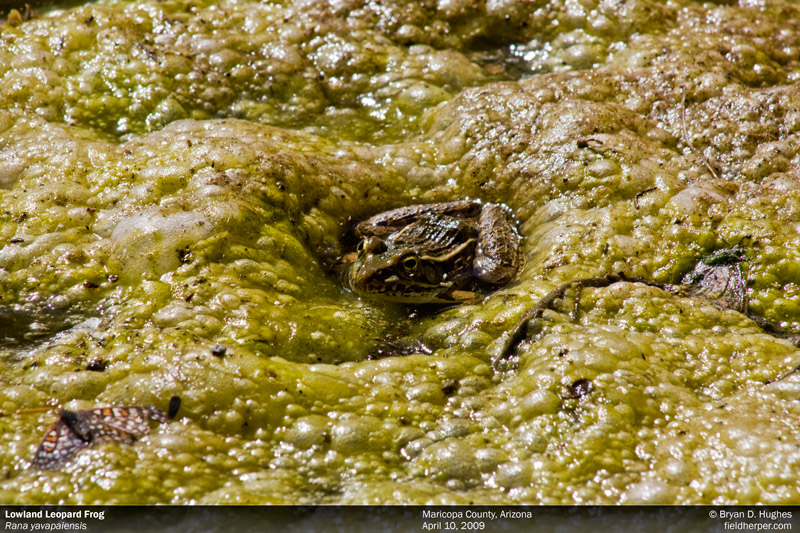
Rana yavapaiensis
Tags: arizona, atrox, black-tailed rattlesnake, canyon treefrog, Crotalus atrox, Crotalus molossus, Diamond back, Diamondback, Diamondback Rattlesnake, Field Herping, field herping arizona, field herping in arizona, Photography, Superstition Mountains, Western Diamondback Rattlesnake
Posted in Field Herping, Field Trips, Photography | No Comments »
Continued from part 1, part 2, and part 3 …
I spent a good part of the day exploring the Northern end of the mountains, where it was too cold to find any animals, but productive nonetheless as I found some great places to visit later in the year. The desert was in bloom and the colors were surprizing.

Superstitions In Bloom
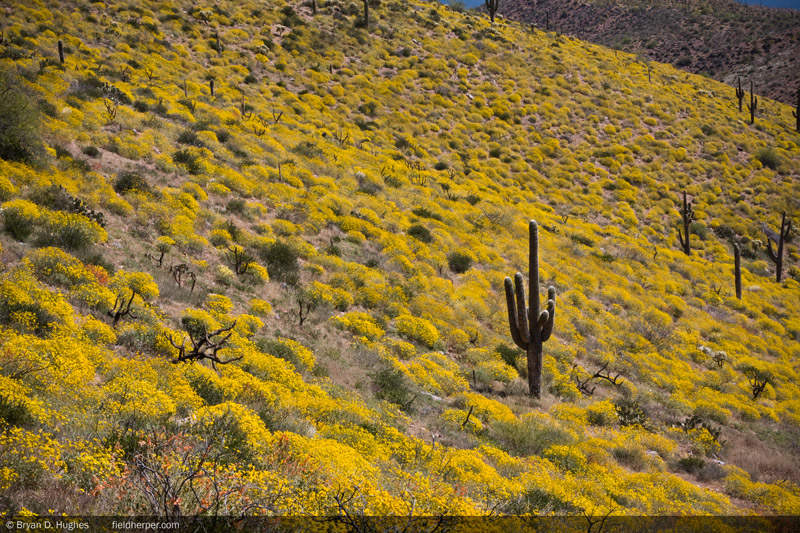
Superstition Mountains
After an uneventful night cruise we decided to get out the flashlights and hike around the stream bed near the campsite, hoping to see some of the amphibians making all that noise. We found quite a few Canyon Treefrogs (hyla arenicolor) and Red-Spotted Toads (Bufo punctatus) active in the colder, moist air.

Hyla arenicolor
I also found this confused Ornate Tree Lizard (Urosaurus ornatus) wandering around the rocks at night. Normally pretty quick, I was able to just reach down and pick this one up. I seldom see these out at night … I wonder what he was up to.
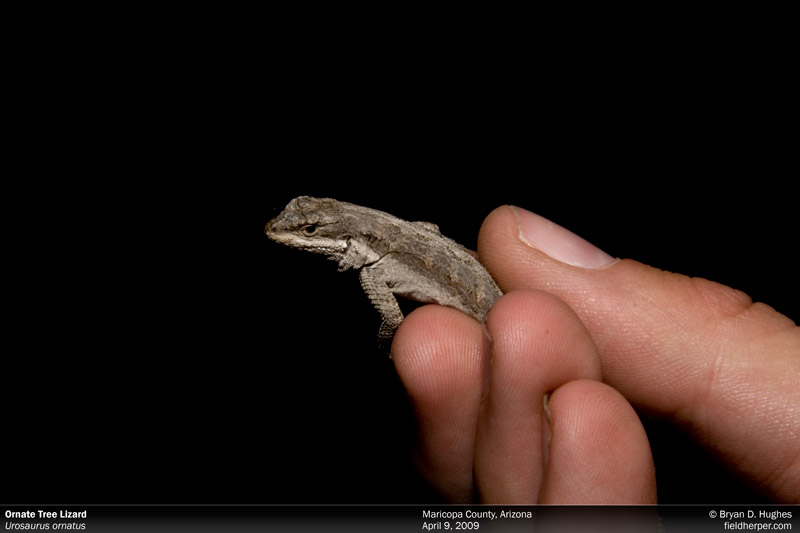
Urosaurus ornatus
The next morning we went for a quick cruise up the canyon to see if any reptiles were awake and warming from the cold night. We didn’t see any snakes, but some big horn sheep climbed up over the road from a nearly vertical cliff on the other side. They let us take photos and didn’t seem at all spooked by the two cars that had stopped to stare. I haven’t seen these before in the wild so it was a nice treat.
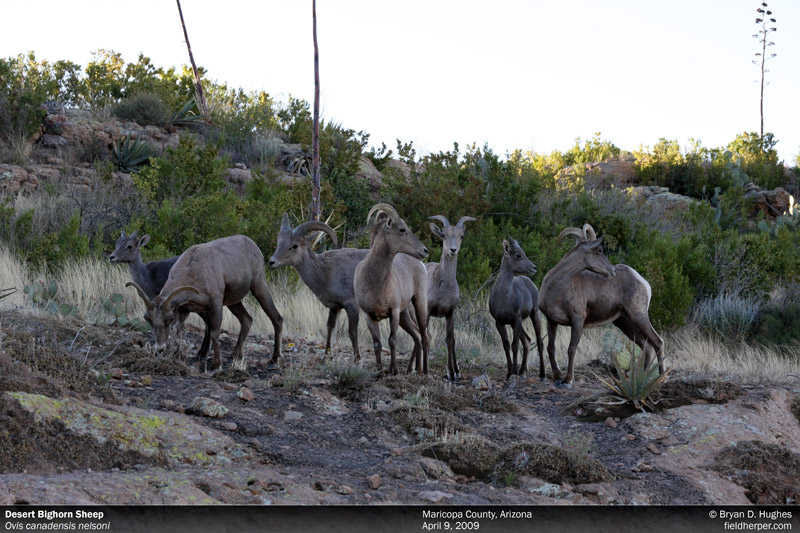
Big Horn Sheep
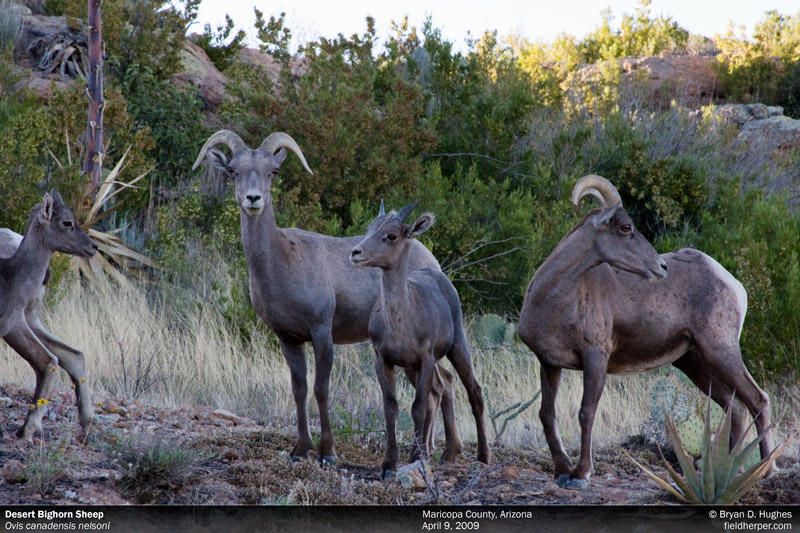
Desert Bighorn Sheep

Ovis canadensis nelsoni
I know they’re not reptiles, but all part of the experience. Always cool to see animals out in their natural environment.
Tags: big horn sheep, bignorn sheep, Bufo punctatus, canyon treefrog, Field Herping, hyla arenicolor, ornate tree lizard, ovis canadensis nelsoni, red-spotted toad, Superstition Mountains, urosaurus ornatus
Posted in Field Herping, Field Trips, Photography | 1 Comment »
… continued from part 1 and part 2.
In the morning, the first thing I found was a biggie for me. It was a Gila Monster (Heloderma suspectum), only my second find of this animal.
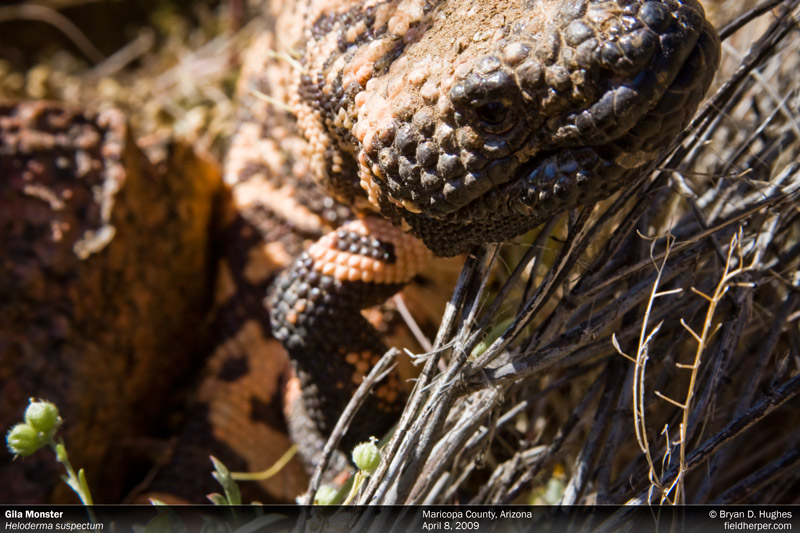
Gila Monster
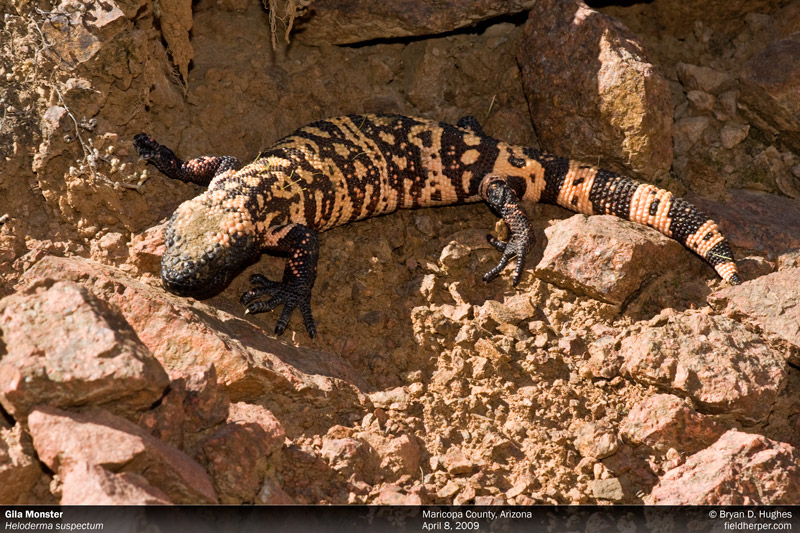
Heloderma suspectum
I took a lot of pictures. I’ve only seen 2 in so many trips to the desert, who knows when the next one would be.

Gila Monster in Arizona
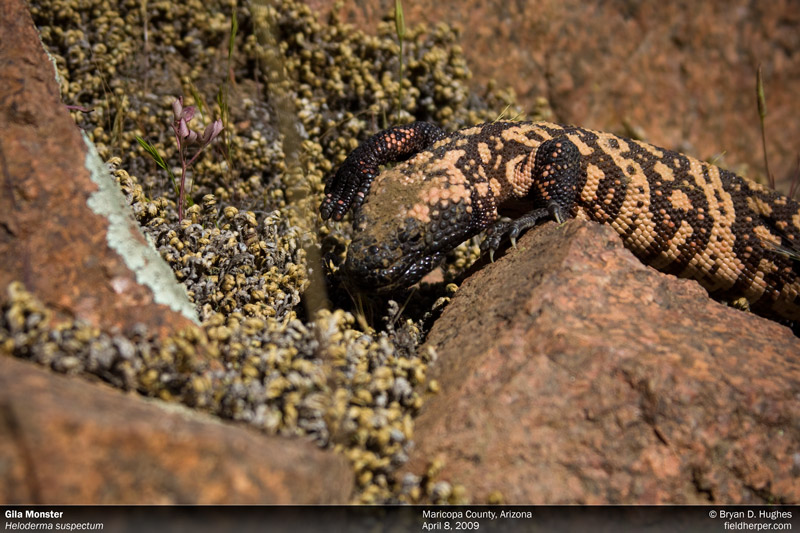
Gila Monster
Although they’re venomous, the bite is most likely not going to be fatal to a human unless there’s some other problem going on. Unlike rattlesnakes, their bite is purely defensive. They’re slow moving animals who just want to get away, and will face you and slowly back up to cover if bothered. I tried my best to keep my distance and let this one do what he was doing and get my photos without hassling him. It was on its way somewhere and I was pleased to follow it for awhile as it did what Gila Monsters do.
Also found with the earlier-mentioned coral snake was this big gross desert bug, the Arizona Desert Centipede (Scolopedra heros arizonensis). They’re the largest centipede in the U.S., capable of reaching up to 12 inches in captivity. Always cool to see, they are one of the few things out here that just creep the hell out of me.
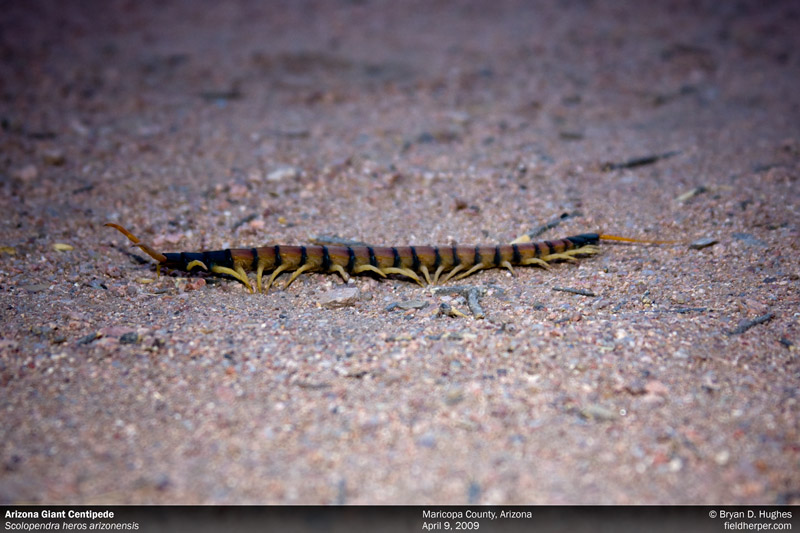
Arizona Desert Centipede

Scolopendra heros arizonensis
Here’s one crawling on a boot, just so you can see how big these things are and why they make me feel like a scared little girl when I’m around them.

Gross dude.
I went back to town at this point to meet up with a couple of guys from Pennsylvania who were out in Arizona to see some desert animals. Right away, we were able to photograph this young adult Sonoran Gophersnake (Pituophis catenifer affinis) enjoying the warm dirt roads of Apache Junction.

Sonoran Gophersnake
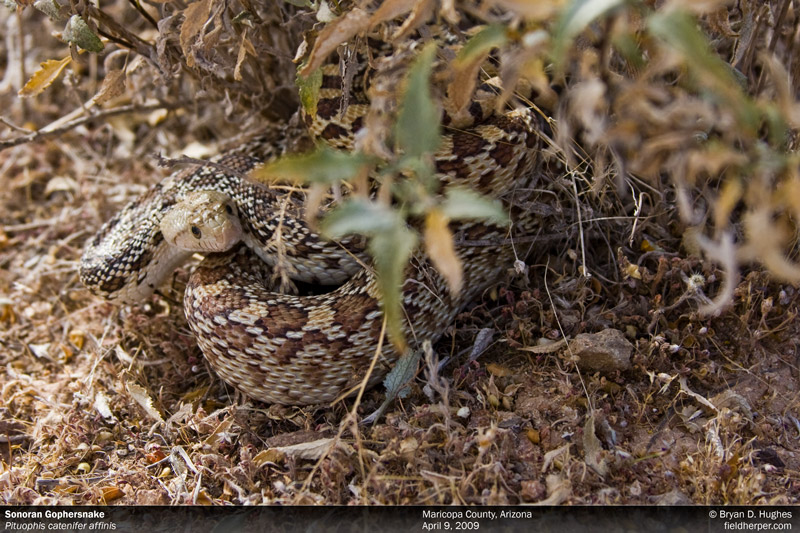
Pituophis catenifer affinis
More to come.
Tags: arizona, Arizona Desert Centipede, Field Herping, Gila Monster, Heloderma suspectum, Photography, Pituophis catenifer affinis, Scolopendra heros arizonensis, sonoran gophersnake, Superstition Mountains
Posted in Field Herping, Field Trips, Invertebrates, Photography | No Comments »
… continued from part 1.
I was really happy to have found this Sonoran Coralsnake (Micruroides euryxanthus) out on the move. This is the 5th I’ve seen, and I was happy to be able to show my new friends from Pennsylvania one of the more elusive venomous snakes we have here in Arizona. This is one of a handful of snakes that can be the only one found on a trip and I’ll still feel completely satisfied seeing it alone.
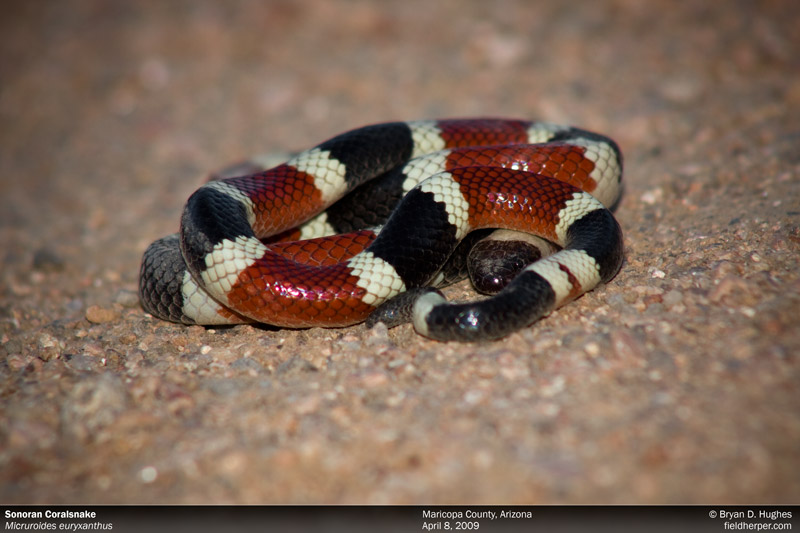
Sonoran Coralsnake
… and a couple more of the same animal.
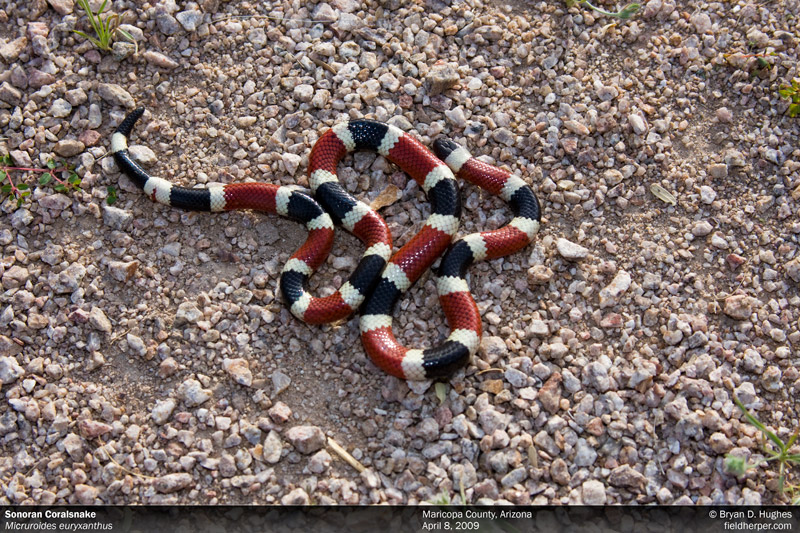
Micruroides euryxanthus
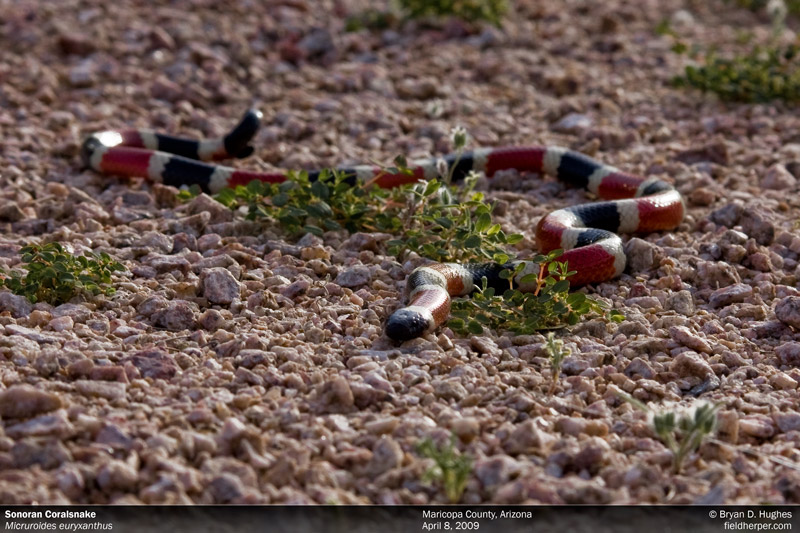
Sonoran Coralsnake
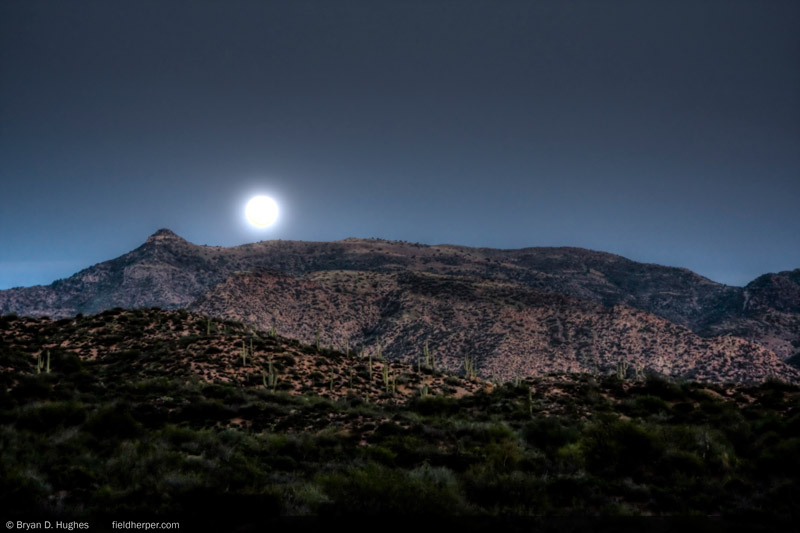
Superstition Mountains
Tags: arizona, field herping in arizona, Micruroides euryxanthus, Sonoran Coralsnake, Superstition Mountains
Posted in Field Herping, Field Trips, Photography | 1 Comment »
On Tuesday night I headed off into the Superstition mountains for a 4-day springtime trip to try and see whatever could be seen. I would be meeting up with a pair of Timber rattlesnake researchers from Pennsylvania the next day to try and find a Black-tailed Rattlesnake (Crotalus molossus) Unfortunately, the weather did not agree with my plans. A cold front moved in to place just as quickly as I did, and the normal April daytime temperatures of 90 degrees dropped to a windy 75. Evening air temperatures were as low as the upper 50’s by 9pm, creating quite a challenge for the next few days. The original plan was to visit the mountains to the South East of Tucson, but I thought we’d have a better chance in my favorite local range, the Superstition mountains to the East of Phoenix.
It was a good sign when I saw this Ground Snake (Sonora Semiannulata) within minutes of arriving on location.
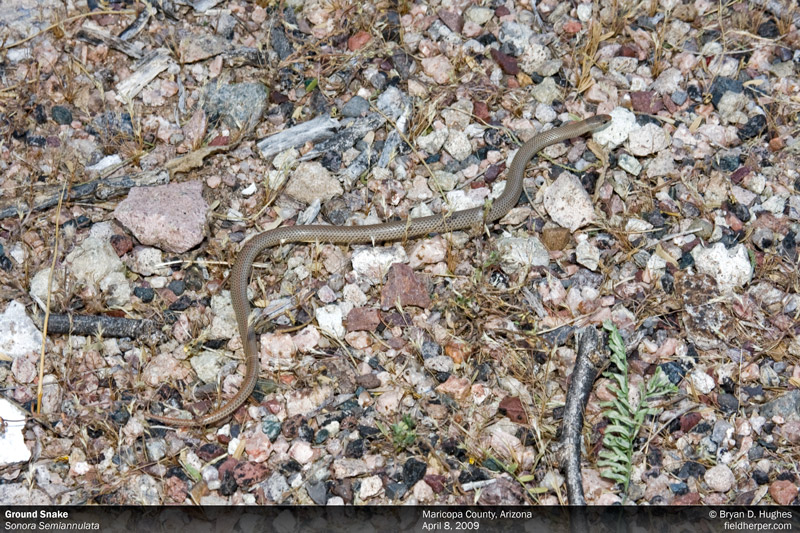
Sonora semiannulata
Groundsnake
Here he is again without the Flash, in the dramatic late-afternoon lighting. I prefer this sort of shot than the ‘field guide’ style above.
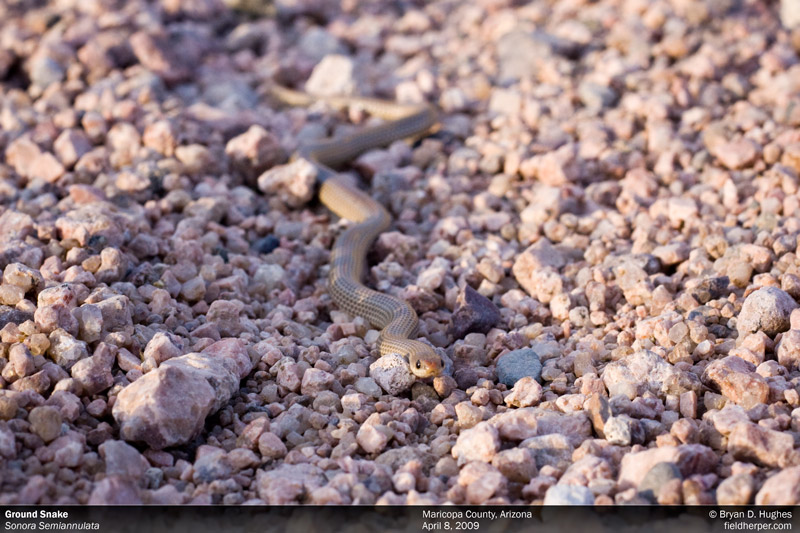
Ground Snake
Sonora semiannulata
When I was done photographing, I watched it crawl into a crack in a rock cut, which was also inhabited by a sub-adult Chuckwalla. The only part visible was the tail; evidence that somebody isn’t as sneaky as they think they are.
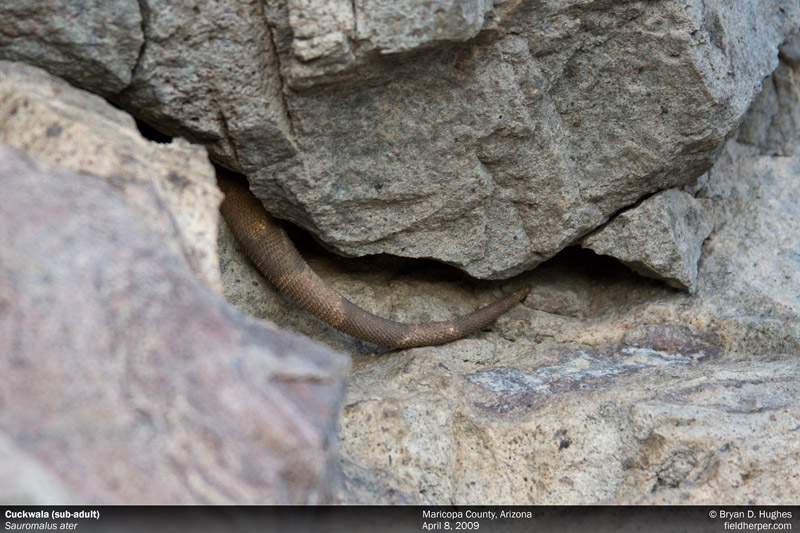
Chuckwalla
That's a weird looking root.
The evening lighting can be quite dramatic in the canyon. I haven’t been able to accurately portray how this place looks with my photos.

Superstition Mountains
One last photograph for this portion of the story; a large Red Spotted Toad (Bufo punctatus):

Red Spotted Toad
Bufo punctatus
Tags: arizona, chuckwalla, field herping arizona, field herping in arizona, ground snake, groundsnake, maricopa county, Photography, pictures, sauromalus ater, scenery, sonora semiannulata, Superstition Mountains
Posted in Field Herping, Field Trips, Photography | 2 Comments »
I spent the weekend putting miles on my legs/car without seeing many animals. It didn’t surprise me being the third week of march in less than ideal conditions. It was still nice to get out and do some exploring, no matter what the results were.
The temperatures were in the high 70s, but the air and ground was bone dry.

Cochise County in Spring
Springtime in Cochise County
The one animal found in 2 days searching Northern Cochise County and Southern Graham County turned up one neonate Mojave Rattlesnake (Crotalus scutulatus) out wandering the flats in relatively cold conditions. It’s hard to tell from the photo, but this little guy was only about as long as a dollar bill.

Crotalus scutulatus
Mojave Rattlesnake

Mojave Rattlesnake
A tiny baby Mojave Rattlesnake
After hiking an area in Southern Graham county with a new friend from Sierra Vista, I went to the Santa Rita mountains to try and find a green rat snake with no luck. I started the 4 hour drive home and decided to make one last-ditch attempt to put something my CF card at a location between Tucson and Phoenix: I saw 4 snakes within 15 minutes. Go figure. These were a large Sonoran Sidewinder (Crotalus cerastes) and his deceased friend just down the road, a young Sonoran Gophersnake (Pituophis catenifer affinis) and an injured Western Diamondback Rattlesnake (Crotalus atrox) that I did not photograph.

Crotalus cerastes cercobombus
Crotalus cerastes cercobombus in Arizona

Sonoran Sidewinder
One of 2 Sidewinder subspecies found within Arizona

Sonoran Gophersnake
A Sonoran Gophersnake found West of Tucson, Arizona
Tags: crotalus cerastes cercobombus, Crotalus scutulatus, Field Herping, gopher snake, mohave, mojave rattlesnake, rattlesnakes in arizona, sonoran gophersnake, sonoran sidewinder
Posted in Field Herping, Field Trips, Photography | 3 Comments »
Kris and I went on a hike up the Agua Fria river to do some herping, but moreso to just get out a bit and enjoy the nice day. Pretty quickly, Kris spotted a Western Diamondback Rattlesnake (Crotalus atrox) under a fallen boulder. I was excited to see a second snake coiled just behind the first. This is the first time I’ve seen 2 snakes share a location like this, so it was pretty exciting.
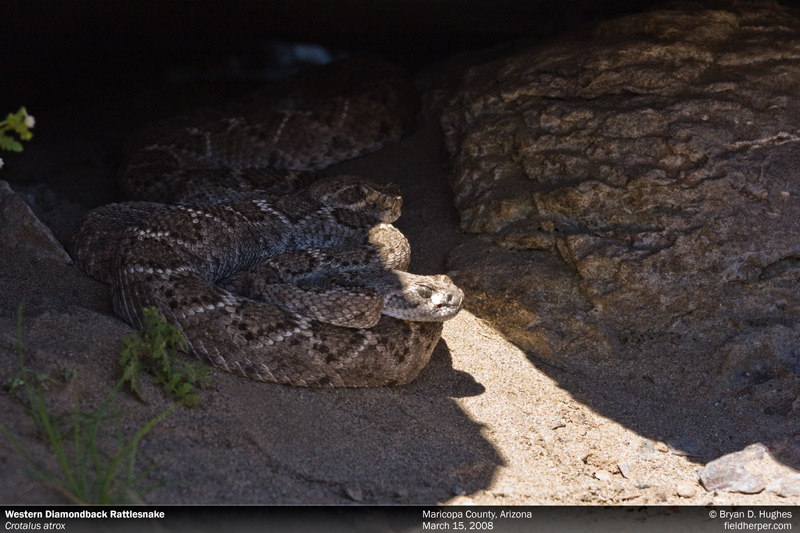
A pair of C. atrox
We assume they’re a mating pair. They did not seem to take notice of us at all, and we were able to take a seat right next to them and watch their behavior for awhile. The male (in back) continually attempted to get the attention of his pal, or was otherwise approaching her head with twitchy head movements and a flickering tongue.
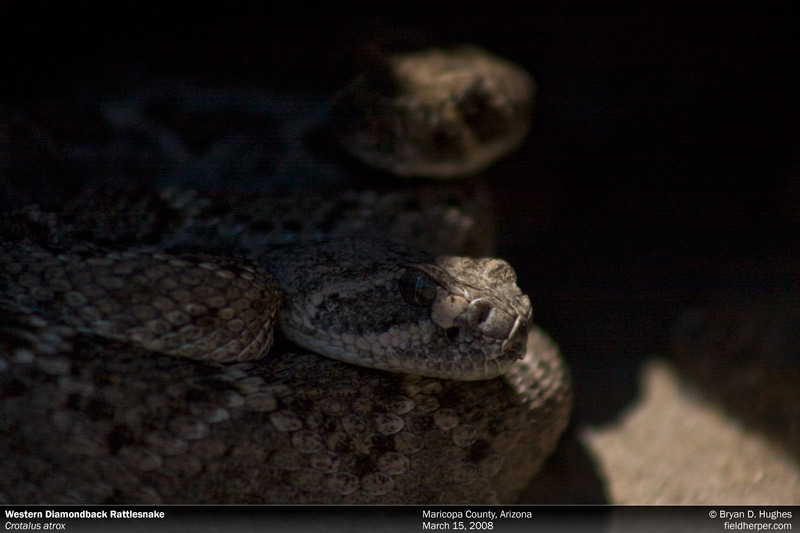
I\'m watching you.
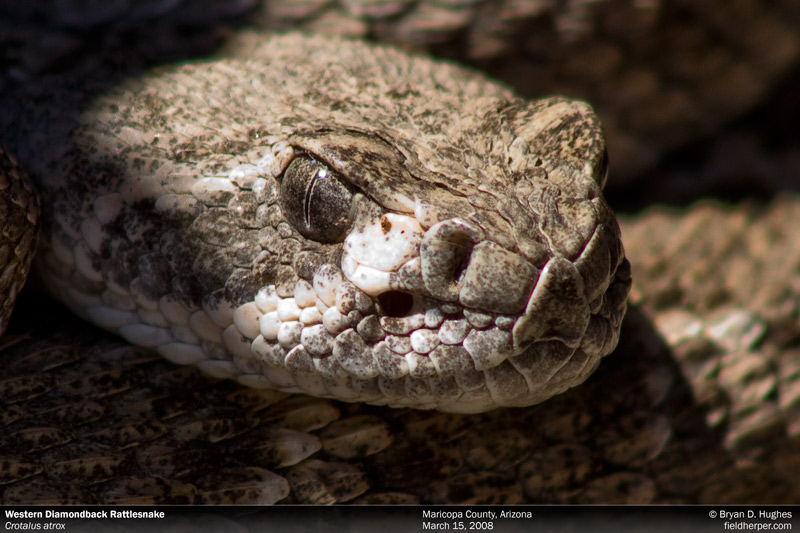
Closeup
A couple other critters from the trip:
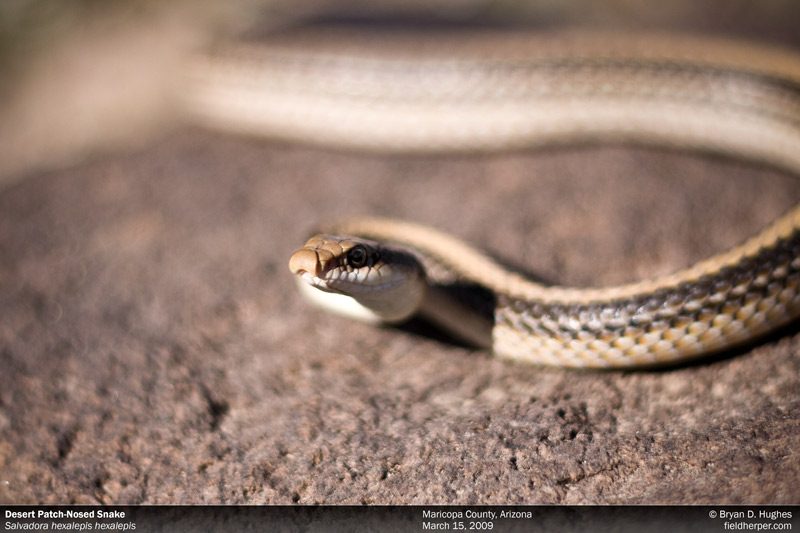
Desert Patch-Nosed Snake
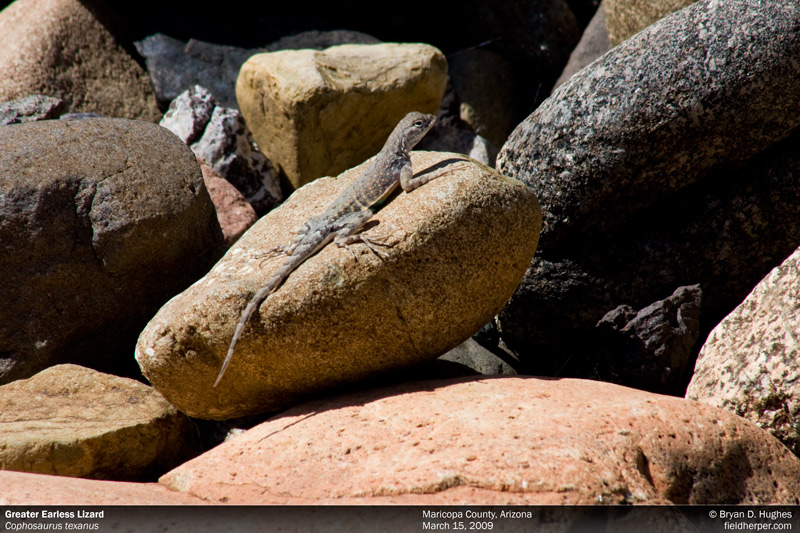
Greater Earless Lizard
Tags: agua fria, Behavior, Cophosaurus texanus, desert patch-nosed snake, Field Herping, greater earless lizard, mating, multiple, patchnose, Salvadora hexalepis hexalepis, Western Diamondback Rattlesnake
Posted in Field Herping, Photography | 1 Comment »
Here’s a cool looking Western Diamondback Rattlesnake (Crotalus atrox) from the North Phoenix area with a lot more dark/chocotate coloration than the more typical greys I see around here. He was very large and fat too, and posed nicely for some photos in the morning sun.

Crotalus atrox

Western Diamondback Rattlesnake

Crotalus atrox
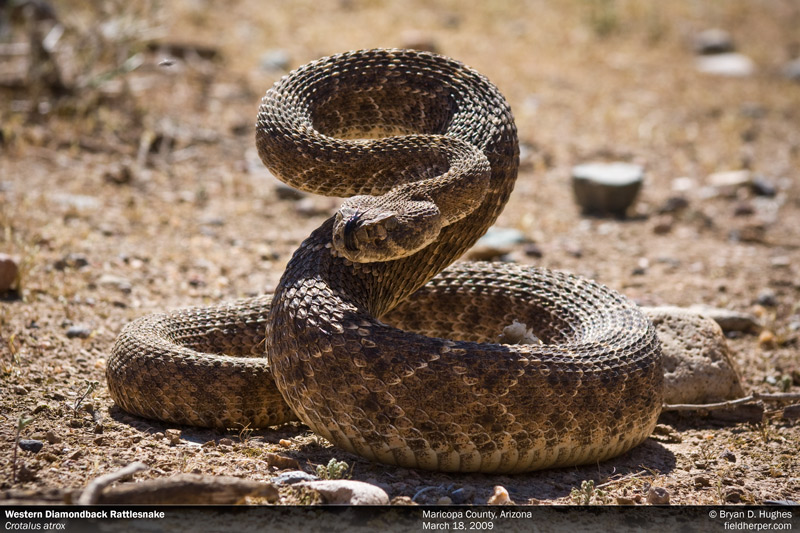
Crotalus atrox
Tags: bryan d. hughes, Crotalus atrox, field herping in arizona, rattle snake, rattle snakes, rattlesnakes, reptiles, snake, snakes, Western Diamondback Rattlesnake
Posted in Photography, Relocation & Rescue | 2 Comments »
Last year I was lucky enough to see a few willardi out and about in South East Arizona. Now that I know what to look for, I hope to see a good amount more this year. Here’s another photo of a large male from my second productive trip into willardi range.

Crotalus willardi
Tags: arizona, bryan d. hughes, crotalus willardi, Field Herping, rattle snake, rattle snakes, rattlesnake, rattlesnakes, ridge nose, ridge-nosed, ridgenose, ridgenosed
Posted in Field Herping | No Comments »


























































